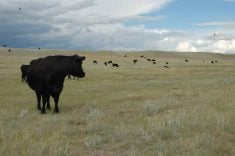A CBC TV report last week that brought hidden camera footage of allegedly inhumane horse slaughter into Canadian living rooms has ignited a fresh debate over the industry.
The issue has spilled over into the public forum, with editorial page writers and coffee shop pundits weighing in on the emotionally charged question of whether horses are pets or protein.
At the centre of the controversy is the Natural Valley Farms slaughter facility in Neudorf, Sask., which began processing horses last year for the export market.
Read Also

Volatile temperatures expected for this winter
DTN is forecasting a lot of temperature variability in the Canadian Prairies this winter. Precipitation should be close to average.
Repeated calls to the plant’s manager, Ken Piller, went unanswered.
Media reports indicate the beef plant began processing horses after its cattle numbers fell short of capacity, and surplus horses from the United States became available following a slaughter ban imposed there last year.
Dr. Anne Allen, a Canadian Food Inspection Agency senior veterinarian who audited Natural Valley four months ago, confirmed that some of the images did appear to be taken at the plant.
She said the plant has European Union certification, which requires that it comply with the most stringent slaughter standards in the world. The plant has also passed audits by the Society for the Prevention of Cruelty to Animals and animal behaviorist Temple Grandin, she added.
The TV footage apparently taken at the killing chute seemed to be the focus of most concern, with one clip showing a plant employee struggling to stun a small horse with a .25-calibre captive bolt gun.
“That 12-second clip, the one they played three times over, it was awful,” said Allen. “Awful for the guy, and hard on the horse. It’s a very difficult job under those circumstances.”
The CFIA identified the potential for problems with chute design since the plant began slaughtering horses, and has been working with Natural Valley to discuss options to fix it, she said.
“The regulations say that (the kill chute) must be appropriate; they don’t really say how wide. The problem is that horses, unlike cattle, come in different sizes,” said Allen, all the way from 400 pound yearlings to 2,200 lb. draft animals.
“In spite of that less than ideal situation, they still have been able to do a good job with animal welfare, which is a testament to the training and compassion of the people that do the job,” she said.
The allegation by animal rights activists that horses were not being properly stunned before being put to the knife doesn’t stand up to scrutiny, she said. Reports that this was happening were first investigated last fall, and the CFIA found them to be baseless.
Frances Wach of the Saskatchewan SPCA said members of her group had been out to inspect Natural Valley in March.
“At the time of our inspection, there was no evidence of inhumane treatment of animals,” she said.
However, Wach added that some recommendations had been made, but declined to list specific concerns.
“Natural Valley is working with our animal welfare officers to address the recommendations.”
Wach added that the SPCA recognizes that the processing of horses for meat is a reality of the equine industry. It supports the enforcement of existing regulations, not a ban.
“What happens if owners have unwanted animals? Will they abandon them or neglect them if they have no value? Will people be willing to pay the euthanasia cost?” she said. “It’s not a simple question.”
Sinikka Crosland, spokesperson for the Canadian Horse Defence Coalition, said the slaughter of horses for meat is “inherently inhumane” and must be abolished.
When asked why her group had the hidden camera footage analyzed by a veterinarian based in Massachusetts, she said, “we know him. We’ve worked with him a bit before. We could have tried to get a vet right there in Manitoba, but we don’t know anyone there.”
Crosland said she is opposed to all consumption of horse meat, whether by humans or as pet food. Public opinion favours a ban, she added
If slaughter was banned, horse owners would have to summon a vet or shoot the animals on their property. On-farm slaughter, even for pet food, wouldn’t be acceptable, she added.
“Then it would become an industry, and again there would be welfare concerns for groups like ours to look at,” said Crosland.
Ultimately, she said, a North America-wide ban would force owners to stop “rampant, irresponsible breeding,” which has flooded the market with unwanted or poor quality horses, she said.
If animal rights activists manage to shut down horse slaughter in Canada, surplus animals in both countries will be taking the long ride south to Mexico, or face neglect or abandonment, said Manitoba Farm Animal Council executive director Shanyn Silinski.
She said there is a disturbing trend by the non-farming public to apply human characteristics to animals.
Even pet food manufacturers are tapping this trend, marketing their products to the owners of “fur kids” or “non-human companions.”
People who keep horses as “companion animals,” she added, may not have the stomach to do the dirty work of euthanizing old or sick animals on their own property.
“Even people who live in the country but don’t farm are isolated from the realities of farming,” she said. “I raise cows and I care about my cows, but in the end, one of them is ending up in my freezer.”














